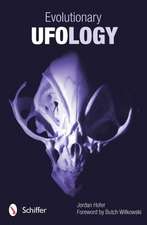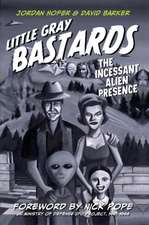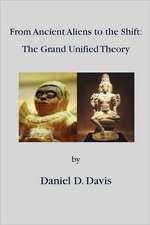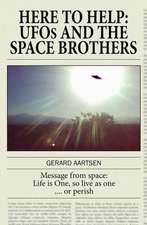Stardust, Supernovae and the Molecules of Life: Might We All Be Aliens?: Astronomers' Universe
Autor Richard Boyden Limba Engleză Paperback – 14 dec 2011
Din seria Astronomers' Universe
-
 Preț: 210.44 lei
Preț: 210.44 lei -
 Preț: 207.15 lei
Preț: 207.15 lei -
 Preț: 195.53 lei
Preț: 195.53 lei -
 Preț: 254.90 lei
Preț: 254.90 lei -
 Preț: 284.56 lei
Preț: 284.56 lei -
 Preț: 212.88 lei
Preț: 212.88 lei -
 Preț: 256.41 lei
Preț: 256.41 lei -
 Preț: 264.35 lei
Preț: 264.35 lei -
 Preț: 259.08 lei
Preț: 259.08 lei -
 Preț: 227.61 lei
Preț: 227.61 lei -
 Preț: 277.98 lei
Preț: 277.98 lei -
 Preț: 305.70 lei
Preț: 305.70 lei -
 Preț: 253.11 lei
Preț: 253.11 lei -
 Preț: 216.60 lei
Preț: 216.60 lei -
 Preț: 272.24 lei
Preț: 272.24 lei -
 Preț: 330.75 lei
Preț: 330.75 lei -
 Preț: 179.00 lei
Preț: 179.00 lei -
 Preț: 289.83 lei
Preț: 289.83 lei -
 Preț: 160.03 lei
Preț: 160.03 lei -
 Preț: 200.80 lei
Preț: 200.80 lei -
 Preț: 255.97 lei
Preț: 255.97 lei -
 Preț: 242.58 lei
Preț: 242.58 lei -
 Preț: 262.55 lei
Preț: 262.55 lei -
 Preț: 282.38 lei
Preț: 282.38 lei -
 Preț: 187.82 lei
Preț: 187.82 lei -
 Preț: 225.19 lei
Preț: 225.19 lei -
 Preț: 104.35 lei
Preț: 104.35 lei -
 Preț: 188.94 lei
Preț: 188.94 lei -
 Preț: 270.50 lei
Preț: 270.50 lei -
 Preț: 212.01 lei
Preț: 212.01 lei -
 Preț: 169.08 lei
Preț: 169.08 lei -
 Preț: 210.01 lei
Preț: 210.01 lei -
 Preț: 208.26 lei
Preț: 208.26 lei -
 Preț: 253.98 lei
Preț: 253.98 lei -
 Preț: 180.12 lei
Preț: 180.12 lei -
 Preț: 280.19 lei
Preț: 280.19 lei -
 Preț: 273.13 lei
Preț: 273.13 lei -
 Preț: 207.39 lei
Preț: 207.39 lei -
 Preț: 208.70 lei
Preț: 208.70 lei -
 Preț: 214.86 lei
Preț: 214.86 lei -
 Preț: 188.94 lei
Preț: 188.94 lei -
 Preț: 194.65 lei
Preț: 194.65 lei -
 Preț: 277.34 lei
Preț: 277.34 lei -
 Preț: 187.15 lei
Preț: 187.15 lei -
 Preț: 210.93 lei
Preț: 210.93 lei -
 Preț: 212.01 lei
Preț: 212.01 lei
Preț: 207.64 lei
Nou
Puncte Express: 311
Preț estimativ în valută:
39.74€ • 43.15$ • 33.38£
39.74€ • 43.15$ • 33.38£
Carte disponibilă
Livrare economică 01-15 aprilie
Preluare comenzi: 021 569.72.76
Specificații
ISBN-13: 9781461413318
ISBN-10: 1461413311
Pagini: 140
Ilustrații: XI, 215 p. 39 illus., 26 illus. in color.
Dimensiuni: 155 x 235 x 20 mm
Greutate: 0.32 kg
Ediția:2012
Editura: Springer
Colecția Springer
Seria Astronomers' Universe
Locul publicării:New York, NY, United States
ISBN-10: 1461413311
Pagini: 140
Ilustrații: XI, 215 p. 39 illus., 26 illus. in color.
Dimensiuni: 155 x 235 x 20 mm
Greutate: 0.32 kg
Ediția:2012
Editura: Springer
Colecția Springer
Seria Astronomers' Universe
Locul publicării:New York, NY, United States
Public țintă
Popular/generalCuprins
Table of Contents.- Preface.- Chapter 1: Introduction.- 1.1: In the Beginning.- 1.2: What is "Life?".- 1.3: The Miller Urey Experiment.- 1.4: General Background and Definitions.- Chapter 2: What is the Origin of the Lightest Elements.- 2.1: The Big Bang.- 2.2: The Supernova Cosmology Project.- 2.3: The Wilkinson Microwave Anisotropy Probe.- 2.4: Olber's Paradox.- 2.5: Big Bang Nucleosynthesis - BBN.- Chapter 3: What is the Origin of the Rest of the Elements?.- 3.1: Introduction to Stellar Nucleosynthesis.- 3.2.1: Hydrogen Burning.- 3.2.2: Helium Burning.- 3.2.3: Subsequent Burning Stages.- 3.3: After Stellar Burning.- 3.3.1: Creating a Core-Collapse Supernova Explosion.- 3.3.2: Synthesizing the Heavy Elements.- 3.3.3: White Dwarfs.- 3.3.4: Type Ia Supernovae.- Chapter 4: Creation of Molecules in the Interstellar Medium.- 4.1: The Electromagnetic Spectrum.- 4.2: Detecting Photons of Different Energies.- 4.3: Secrets from Meteorites.- 4.4: Mining the Comets.- 4.5: The Next Huge Step - Forming Life from the Molecules Delivered to Earth.- Chapter 5: Amino Acids and Chirality.- 5.1: A Primer on Amino Acids.- 5.2: Chirality and Polarization.- 5.3: Relating Optical and Molecular Chirality.- 5.3.1: Chiral Selection.- 5.3.2: A Little Atomic Physics and Some Very Basic Quantum Mechanics.- 5.4: The Other Molecules of Life.- Chapter 6: How Have Scientists Explained the Amino Acid Chirality?.- 6.1: Models that Produce Chirality.- 6.1.1: Chiral Selection via Circularly Polarized Sunlight.- 6.1.2: Chiral Selection via Circularly Polarized Sunlight.- 6.1.3: Chiral Selection via the Weak Interaction.- 6.1.4: Chiral Selection via Chemical Selection in Clay.- 6.2: Amplification via Chemical Catalysis.- 6.3: Laboratory Experiments and Theoretical Developments.- 6.4: Terrestrial Amplification.- 6.5: Concluding Remarks on Amplification.- Chapter 7: What Happens to the Amino Acids When the Supernova Explodes?.- 7.1: The Supernova.- 7.2: The Neutrino Story.- 7.3: Interactionsof Neutrinos with 14N.- 7.4: Relating the 14 N Spin to the Molecular Chirality.- 7.5: The Supernova Progenitor Star.- Chapter 8: Spreading Chirality Throughout the Galaxy and Throughout the Earth.- 8.1: Might Supernovae Process All the Amino Acids in the Galaxy?.- 8.2: Spreading Molecules and Enantiomerism Throughout the Galaxy.- 8.2.1: Cosmic Amplification.- 8.2.2: Cosmic Amplification.- 8.2.2: Galactic Mixing.- 8.2.3: Planetary Amplification.- 8.3: Testing the Models of Amino Acid Chirality.- 8.4: The Impact of Amino Acid Chirality on Questions of the Origin of Life in the Universe.- Chapter 9: What About the Rest of the Universe?.- 9.1: Are We Alone?.- 9.2: Extremophiles on Earth.- 9.3: And From Outer Space?.- Glossary.- Index.
Recenzii
From the reviews:
“Book shows the reader first the beginning of atoms and molecules, and how they formed, and then continues with the intriguing question of chirality in molecules, and in amino acids in particular. … presented in an easily understandable way with several schematics and images to explain some of the concepts. … presents an interesting topic, that is certainly exciting and informative for the general reader, showing connections between various fields of research, and different astronomical objects and life on Earth.” (Kadri Tinn, AstroMadness.com, April, 2014)
“Boyd … presents a summary of his work and that of his colleagues in which the left-handed symmetry is postulated to result from exposure of the amino acids to circularly polarized starlight during their formation in space. … the book serves as an in-depth introduction to the topic of the extraterrestrial origin of amino acids. … The text is very lucid and accessible to general readers … . Summing Up: Recommended. Lower-division undergraduates through graduate students; informed general readers.” (A. Spero, Choice, Vol. 49 (11), August, 2012)
“Book shows the reader first the beginning of atoms and molecules, and how they formed, and then continues with the intriguing question of chirality in molecules, and in amino acids in particular. … presented in an easily understandable way with several schematics and images to explain some of the concepts. … presents an interesting topic, that is certainly exciting and informative for the general reader, showing connections between various fields of research, and different astronomical objects and life on Earth.” (Kadri Tinn, AstroMadness.com, April, 2014)
“Boyd … presents a summary of his work and that of his colleagues in which the left-handed symmetry is postulated to result from exposure of the amino acids to circularly polarized starlight during their formation in space. … the book serves as an in-depth introduction to the topic of the extraterrestrial origin of amino acids. … The text is very lucid and accessible to general readers … . Summing Up: Recommended. Lower-division undergraduates through graduate students; informed general readers.” (A. Spero, Choice, Vol. 49 (11), August, 2012)
Notă biografică
Dr. Richard Boyd was the Science Director of the National Ignition Facility, Lawrence Livermore National Lab from 2007-2010 and now serves as a staff physicist at LLNL. He earned his Ph.D. in physics from the University of Minnesota in 1967, and has been a physics professor at the University of Rochester from 1972 to 1978 and a professor of physics and astronomy at Ohio State University from 1984 to 2002. Dr. Boyd also served as a program officer at the National Science Foundation from 2002 to 2006, managing the NSF portfolios in nuclear and particle astrophysics as well as nuclear physics. Following that, he was a visiting professor at the National Astronomical Observatory in Japan. Dr. Boyd has enjoyed a research career that resulted in more than 200 publications, both experimental and theoretical, and one graduate-level textbook on nuclear astrophysics. He was awarded an Outstanding Scholar award from Ohio State University in 1982, and was named a Fellow of the American Physical Society and of the American Association for the Advancement of Science. He was named an honorary Native American of the Santa Clara Pueblo in 1997, and an Eminent Scientist of the Institute for Physical and Chemical Research in Japan in 1998-1999.
Textul de pe ultima copertă
Where were the amino acids, the molecules of life, created: perhaps in a lightning storm in the early Earth, or perhaps elsewhere in the cosmos? This book argues that at least some of them must have been produced in the cosmos, and that the fact that the Earthly amino acids have a specific handedness provides an important clue for that explanation. The book discusses several models that purport to explain the handedness, ultimately proposing a new explanation that involves cosmic processing of the amino acids produced in space. The book provides a tour for laypersons that includes a definition of life, the Big Bang, stellar nucleosynthesis, the electromagnetic spectrum, molecules, and supernovae and the particles they produce.
Caracteristici
Gives a detailed description of handedness of the amino acids, a critical element in understanding their origin, as well as a plausible model by which their handedness could have been produced Relates everything to basic physical properties and forces of nature, written in lay person language, which no other book on the molecules of life does Offers discussions of some fascinating aspects of modern physics that impinge on the question of amino acid origin, e.g., the big bang, neutrino physics, and supernovae Includes supplementary material: sn.pub/extras




















